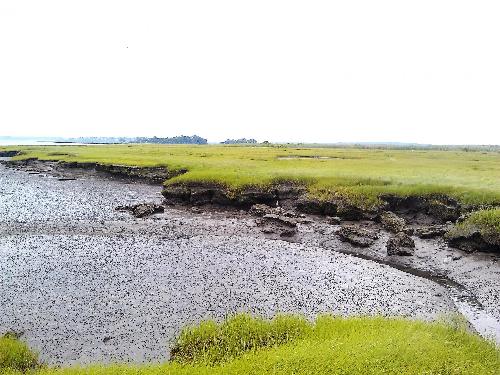(Boston) - For salt marshes, hurricanes are just another day at the beach.
These coastal wetlands are in retreat in many locations around the globe--raising deep concerns about damage to the wildlife that the marshes nourish and the loss of their ability to protect against violent storms. The biggest cause of their erosion is waves driven by moderate storms, not occasional major events such as Hurricane Sandy, researchers from Boston University and the United States Geological Survey now have shown.
"Waves are very powerful because they attack the marsh in its weakest part," says Nicoletta Leonardi, a Ph.D. candidate at BU's Department of Earth & Environment and lead author on a paper published in the journal PNAS. "Generally, the more a salt marsh is exposed to waves, the faster it is eroding."

Analyzing eight salt marsh locations in Australia, Italy and the United States, "we found that the behavior of salt marshes is very predictable," says Leonardi, with a constant relationship between wave energy and the speed of marsh erosion.
In fact, the work shows that hurricanes and other violent storms contribute less than 1 percent of salt marsh deterioration in those marshes, says Sergio Fagherazzi, BU Earth & Environment associate professor and co-author on the paper.
Along the New England coast, for example, the moderate northeast storms that may hit every few months strip away far more from the marshes than the hurricanes that may sweep through a few times a decade. "Salt marshes survive for thousands of years, which means they know how to cope against hurricane waves," he says.
In a major storm, "beaches or dunes on a beach just collapse all at once," Fagherazzi adds. "Marshes don't, which is a major advantage if you are serious about using them for hazard mitigation and coast protection."
"While hurricanes are catastrophic events, the salt marsh doesn't respond catastrophically," says Neil Kamal Ganju, a co-author and research oceanographer with USGS in Woods Hole, Massachusetts. In addition to the infrequency of hurricanes, that may be because a hurricane's surge brings up water level so high over a marsh that waves have relatively little effect, he suggests.
Improved knowledge about salt marsh erosion brings an important new tool to those responsible for management and restoration of wetlands. "You can take the geography of a salt marsh and the estuary around it, and if you understand the wind climate and the wave climate, using historical data, you now can predict the marsh erosion," says Ganju.
Globally, salt marshes are being lost to waves, changes in land use, higher sea levels, loss of sediment from upstream dams and other factors. This puts at risk "a lot of ecosystem services that we need to preserve," Leonardi emphasizes. Many initiatives around the world now seek to protect and rebuild salt marshes. Evidence also suggests that, at least in some coastal environments, marshes can adapt to rising sea levels.
In the United States, the U.S. Army Corps of Engineers and many cities want to manage salt marshes as "living shorelines" that act as buffers between coastal communities and the ocean, Fagherazzi says. Such efforts kicked off in New Jersey and New York after Hurricane Sandy in 2012, and around New Orleans after Hurricane Katrina in 2005.
The effect of waves on salt marsh erosion, part of a USGS project to examine the response of estuaries to Hurricane Sandy, is being integrated into a USGS numerical model called COAWST (Coupled-Ocean-Atmosphere-Wave-Sediment Transport). COAWST combines models of ocean, atmosphere, waves and sediment transport for analysis of coastal change.
Better understanding of marsh erosion also may help in modeling carbon storage as it relates to climate change, the scientists say.




Comments